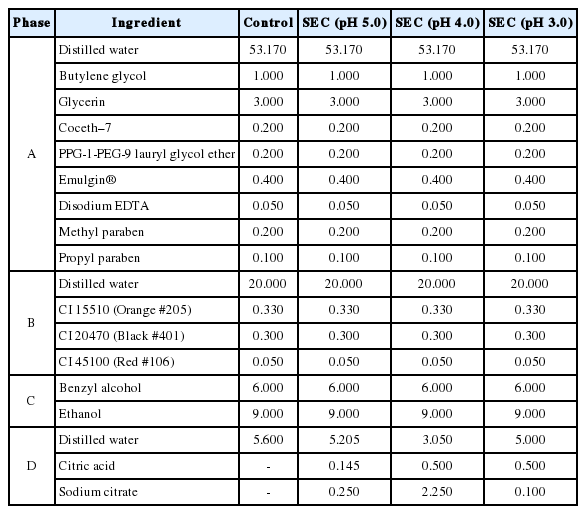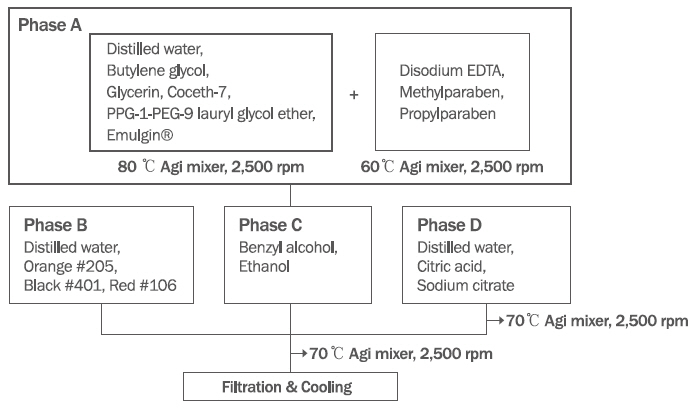pH 레벨에 따른 세미퍼머넌트 아이브로우 제품의 관능평가
Sensory Evaluation of Semi-permanent Eyebrow Cosmetics Depending on Different pH Levels
不同酸碱度的半永久性眉毛化妆品的感官评价
Article information
Abstract
목적
세미퍼머넌트 아이브로우 제품은 눈썹에 색상이 일시적으로 착색되어 일정기간 동안 메이크업 효과가 지속되는 장점을 지니고 있다. 제품의 지속력에 가장 중요한 요인은 제형과 pH 레벨에 따른다.
방법
이 연구에서는 액상형의 세미퍼머넌트 아이브로우 화장품의 pH를 조절하여 Control (pH 6.0), Sample A (pH 5.0), Sample B (pH 4.0), Sample C (pH 3.0)를 제조하였다. 제조된 시료들의 제품 색상을 측정하였으며, 30명의 패널을 모집하여 사용 후 관능평가를 실시하였다.
결과
시료의 제품 색상 측정 결과 Control과 Sample A, B, C의 색상 특성이 다르게 나타났는데, 제조 시 동량의 색재를 사용하였더라도 pH 조절제에 의해 제품색의 변형이 나타난 것을 확인하였다. 또한 관능평가 결과 pH 4.0과 3.0에 해당하는 Sample B와 C의 착색 및 지속력에 대한 만족도가 높게 나타났는데 이러한 결과는 제품의 pH 조절에 따라 낮은 pH의 제품이 착색 및 지속력이 우수하게 평가되는 것을 알 수 있었다.
결론
화장품의 관능평가는 제품의 시판화를 위한 가장 실용적인 평가방법이라 할 수 있다. 이 연구결과에서 낮은 레벨의 pH를 적용한 세미퍼머넌트 아이브로우 제품이 제품 착색 및 지속력에서 우수한 평가 결과를 보였으며 이에 따른 활용가능성제을시 하였다.
Trans Abstract
Purpose
Sensory perception and performance are important aspects for the successful development of cosmetic in the market. In this study, we aimed to prepare semi-permanent eyebrow formulations and perform a sensory evaluation of the same.
Methods
We prepared semi-permanent eyebrow cosmetic (SEC) formulations of different pHs (pH 3.0, 4.0, 5.0 and 6.0) and evaluated the sensory attribute on a 5-point Likert scale. The test panel comprised women aged 20-39 years who were SEC users and were recruited from an organization via invitation.
Results
In sensory evaluation, no difference was noted among samples regarding their spreadability and usability. This is attributable to the fact that the tested samples were prepared in the same form as the liquid type of SECs. The SEC (pH 3.0) and SEC (pH 4.0) showed a high satisfaction level for the color strength and tenacity. These results are likely to be related to the pH regulator components (i.e., citric acid and sodium citrate).
Conclusions
The following was the prominent finding of the sensory evaluation: formulations with a low pH (<4.0) are beneficial for maintaining the coloration (i.e., color strength and tenacity) in SECs.
Trans Abstract
目的
感官感知和性能是化妆品市场成功发展的重要方面。本研究旨在制备半永久性眉毛配方,并对其进行感官评价。
方法
制备不同pH(pH3.0、4.0、5.0和6.0)的半永久性眉毛化妆品(semi-permanent eyebrow cosmetic, SEC)配方,用里克特五级量表评价其感官特性。测试小组由20-39岁的女性组成,她们是SEC的用户,并通过邀请从一个组织中招募。
结果
在感官评价中,各样品在铺展性和可用性方面无明显差异。这是由于测试样品的制备形式与液体类型的SEC相同。SEC(pH3.0)和SEC(pH4.0)对颜色强度和韧性的满意度较高。这些结果可能与pH调节成分(即柠檬酸和柠檬酸钠)有关。
结论
通过以上研究显著发现低pH(<4.0)的配方有助于在秒内保持着色(即颜色强度和韧性)。
Introduction
The eyebrow cosmetics that had been used are in form of powder, gel, and pencil. Recently, the use of semi-permanent eyebrow cosmetic had been trending worldwide and had been shown to have great advantage (Hong, 2018) in keeping the color on the eyebrows for a certain time period. The long-lasting effect of semi-permanent cosmetics mainly depends on the pH level and properties of the pigments.
The surrounding pH increases in an area where the pH is always around 6 due to human homeostasis (Lambers et al., 2006); this leads to the release of the cosmetic ingredients from the particles and their absorption through the skin (Lee & Kim, 2011; Zografi, 1985). Li et al. (2012) reported that the penetration and absorption of azelaic acid had a strong pH- and vehicle-dependency. In addition, pH values between 4.0 and 5.0 appeared to provide the most favorable environment for passive diffusion since the concentration of unionized methotrexate would be optimal in this range (Vaidyanathan et al., 1985).
This study was based on the importance of the pH effect on percutaneous absorption, although the material and formulation used were different. We prepared semi-permanent eyebrow cosmetic formulations at various pH levels of 3.0, 4.0, 5.0, and 6.0.
Market success is governed by fulfilling research expectations, and by the customer identified sensory attributes that dominate. This implied that sensory analysis significantly contributed to the characterization of individual products (Moravkova & Filip, 2016). The advantage of sensory evaluation is that the quality of the products is perceived by the end users. The objective of this study is was sensory evaluation of semi-permanent eyebrow cosmetic formulations at various pH levels, with emphasis of characterization of semi-permanent eyebrow cosmetics.
Methods
1. Materials and preparation
The ingredients of the cosmetics included solvents, thickeners, sequestering agents, preservatives, pigments, and pH regulators. The pH regulators were obtained as a sodium acid from Duksan Pure Chemicals Co., Ltd. (Ansan, Korea) and as citric acid from RZBC Co., Ltd. (Shandong, China). The pigments and ingredients were purchased from Sigma-Aldrich (USA). The composition of the semi-permanent eyebrow cosmetics is shown in Table 1.
Phase A was prepared by dissolving 1 g butylene glycol, 3 g glycerin, 0.2 g Coceth-7, 0.2 g PPG-1-PEG-9 lauryl glycol ether, 0.4 g emulgin, 0.05 g disodium EDTA, 0.2 g methylparaben, and 0.1 g propylparaben in 53.17 g of distilled water. Phase B consisted of 0.33 g orange #205, 0.3 g black #401, and 0.05 g red #106 dissolved in 20 g distilled water. Phase C was prepared by mixing 6 g benzyl alcohol, and 9 g ethanol. Phase D consisted of citric acid and sodium citrate, which were the pH regulators. The amount of pH regulator was different for each sample. A, B, C and D phases were mixing to manufacture the semi-permanent eyebrow cosmetics. Thereafter, the pH regulators were added to the semi-permanent eyebrow cosmetics and mixed using the homomixer. The prepared A, B, C and D phases were mixed, defoamed and filtered, and stored in a cold sealed state. The preparation process of semi-permanent eyebrow cosmetic is showen in Figure 1. The prepared semi-permanent eyebrow cosmetics conformed the fundamentals of stability test (Cannell, 1985).
2. Panel recruiting
The panels comprised 30 women in the organization who were aged between 20-39 years and who were semi-permanent eyebrow cosmetic users. Informed consent was obtained from the subjects after providing them with written and oral information about this study. The study protocol was approved by the ethics committee of Wonkwang University (Registration No. WKIRB 201706-038-02). The panels were blinded to the information on the sample's pH level and used the prepared semi-permanent eyebrow cosmetics (i.e., control, SEC (pH 5.0), SEC (pH 4.0) and SEC (pH 3.0)). The subjects were asked to evaluate the sensory attributes of spreadability, color strength, tenacity, usability by the 5-Likert scale.
3. Color measurement of semi-permanent eyebrow cosmetic
The 25 μL of semi-permanent eyebrow cosmetics was applied on the opacity chart, and the samples were allowed to dry at room temperature for 30 min. The film thickness of the semi-permanent eyebrow cosmetics was 10 μm in each sample. The samples' colorant was determined using a spectrum colorimeter with Φ an 8 mm aperture size (CM-700d Spectrophotometer Minolta, Tokyo, Japan). The color value was measured as the CIE color system (L*, a*, and b*). The value for the whiteness index was displayed only when the observer 10° and the illuminant D 65 were selected.
4. Sensory analysis
The panel was requested to score each of the four semi-permanent eyebrow cosmetics after seven days of actual use. Four sensory attributes were chosen and included spreadability on the eyebrow, color strength after cleansing, tenacity on the skin, and usability (Table 2). The scales ranged from 1 (very dissatisfied) to 5 (very satisfied) using a 5-Likert scale.
5. Statistical analysis
All the statistical analyses were conducted using SPSS ver. 24.0 software (SPSS Inc., USA). The data were presented as mean and standard deviation. The results were subjected to one-way analysis of variance, and significant differences were determined by the Duncan's multiple range test at p<0.05.
Results and Discussion
From the values of the lightness (L*), yellowness (a*), and redness (b*) components, we can obtain a better understanding of the characteristics of the total color difference among the samples (Melgosa et al., 2018). The color values of the semi-permanent eyebrow cosmetics based on the spectrum colorimeter are shown in Table 3. The mean value of control color values was L*=31.29, a*=-0.4, b*=-0.23, which indicated dark gray without yellowness and redness. The color values of the SEC (pH 5.0), SEC (pH 4.0), and SEC (pH 3.0) were in the same series of dark brown. Notably, all samples from the semi-permanent eyebrow cosmetics, comprised equivalent amount of the pigment ingredients, although there was a difference between among the color values of samples. There was a tendency of having more reddish and yellowish coloration in the samples that contained pH regulators. One interesting finding was that the pH regulator affected the colorant of the semi-permanent eyebrow cosmetics. In accordance with the present result, Seo et al. (2017) reported that anthocyanin pigments were especially sensitive to pH and the redness (a*) increased in acid.
The results of the sensory analysis are numerically summarized in Table 4 and graphically depicted in Figure 2. The spreadability and usability were not significantly difference among the groups. The cosmetics may have contained the controlling factor in the release of the active ingredient from the formulation. This result can be explained by the fact that the tested samples were prepared in the same form as the liquid type of semi-permanent eyebrow cosmetics.

Graphic evaluation of the sensory attributes.
Graphic organize is a visual display that demonstrates relationships between sensory attributes. Data are show as mean (N=30). Control, pH 6.0, did not contain the pH regulator; SEC (pH 5.0), semi-permanent eyebrow containing 0.145 g citric acid and 0.25 g sodium citrate; SEC (pH 4.0), semi-permanent eyebrow containing 0.5 g citric acid and 2.05 g sodium citrate; SEC (pH 3.0), semi-permanent eyebrow cosmetic, containing 0.5 g citric acid and 0.1 g sodium citrate.
In terms of color strength, satisfaction was higher for the SEC (pH 5.0), SEC (pH 4.0) and SEC (pH 3.0) than for the control. Furthermore, SEC (pH 4.0) and SEC (pH 3.0) had the highest satisfaction for tenacity among the tested samples. These results were likely to be related with the pH regulator contained in the samples. Most cosmetics or pharmaceuticals are formulated at pH values at least below 5.0, based on the understanding that such pH is beneficial for the human skin. Acidic formulations are well known to be more effective at a lower pH because of the increased skin penetration of the active ingredient (Blaak et al., 2017; Wiechers et al., 2006). The pH range of cosmetics regulated by the Korea Food and Drug Administration (KFDA) is pH 3.0 to 9.0. However, Song et al. (2018) reported that 3.3% developed skin irritation on human repeat insult patch test after 48 hours of exposure to a semi-permanent eyebrow cosmetic at pH 3.0. Cosmetic are products used over long periods by the public and their safety is very important (Alani et al., 2013; An et al., 2014; Aschenbeck et al., 2017). The result of that previous study indicated than the acidic pH 3.0 of semi-permanent eyebrow cosmetics may have caused the doubtful reaction with continuous use, although an acidic pH 3.0 cosmetic is available and is regulated by the KFDA.
Conclusion
Sensory analysis of the use of semi-permanent eyebrow cosmetics showed a significantly high satisfaction with color strength and tenacity at a lower pH level. The formulation with a lower pH level (below 4.0) was beneficial for maintaining the coloration (color strength and tenacity) of the semi-permanent eyebrow cosmetic.
Notes
This work is part of the Su-jin Yu's Ph.D. thesis at the University of Wonkwang, Iksan, Korea
Acknowledgements
This work was supported by the National Research Foundation of Korea Grant funded by the Korean Government (NRF-2017S1A5B5A02025240).




